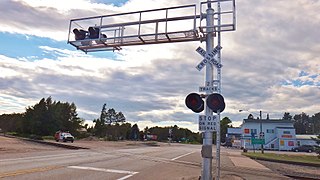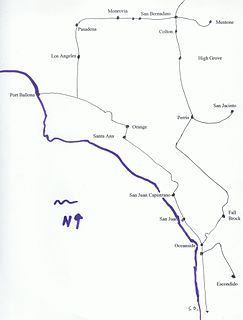
The Pacific Electric Railway Company, nicknamed the Red Cars, was a privately owned mass transit system in Southern California consisting of electrically powered streetcars, interurban cars, and buses and was the largest electric railway system in the world in the 1920s. Organized around the city centers of Los Angeles and San Bernardino, it connected cities in Los Angeles County, Orange County, San Bernardino County and Riverside County.

BNSF Railway is one of the largest freight railroads in North America. One of seven North American Class I railroads, BNSF has 35,000 employees, 32,500 miles (52,300 km) of track in 28 states, and nearly 8,000 locomotives. It has three transcontinental routes that provide rail connections between the western and eastern United States. BNSF trains traveled over 169 million miles in 2010, more than any other North American railroad.

Wigwag is a nickname for a type of railroad grade crossing signal once common in North America, referring to its pendulum-like motion that signaled the approach of a train. The device is generally credited to Albert Hunt, a mechanical engineer at Southern California's Pacific Electric (PE) interurban streetcar railroad, who invented it in 1909 for safer railroad grade crossings. The term should not be confused with its usage in Britain, where "wigwag" generally refers to alternate flashing lights, such as those found at modern level crossings.

The Atchison, Topeka and Santa Fe Railway, often referred to as the Santa Fe or AT&SF, was one of the larger railroads in the United States. The railroad was chartered in February 1859 to serve the cities of Atchison and Topeka, Kansas, and Santa Fe, New Mexico. The railroad reached the Kansas–Colorado border in 1873 and Pueblo, Colorado, in 1876. To create a demand for its services, the railroad set up real estate offices and sold farmland from the land grants that it was awarded by Congress.
Albert C. Hunt was the inventor of the wigwag, a grade crossing signal used in transportation. Hunt was a mechanical engineer from Southern California. He invented the wigwag in the early 1900s out of the necessity for a safer railroad grade crossing. Hunt was associated with the Pacific Electric interurban streetcar railroad.

The Alameda Corridor is a 20-mile (32 km) freight rail "expressway" owned by the Alameda Corridor Transportation Authority that connects the ports of Los Angeles and Long Beach with the transcontinental mainlines of the BNSF Railway and the Union Pacific Railroad that terminate near downtown Los Angeles, California. Running largely in a trench below Alameda Street, the corridor was considered one of the region's largest transportation projects when it was constructed in the 1990s and early 2000s.

The Illinois Railway Museum is the largest railroad museum in the United States. It is located in the Chicago metropolitan area at 7000 Olson Road in Union, Illinois, 55 miles (89 km) northwest of downtown Chicago.

Union Switch & Signal was an American company based in Pittsburgh, Pennsylvania, which focused on railway signaling equipment, systems and services. The company was acquired by Ansaldo STS in 1988, operating as a wholly-owned company until January 2009, when US&S was renamed "Ansaldo STS USA" to operate as a subsidiary of Ansaldo in the Americas and Asia.

The Griswold Signal Company was an American company focused on railway signalling, based in Minneapolis, Minnesota. Founded by Minnesota native Franklin Wolcott Griswold, the company manufactured traffic signals and railroad level crossing signals.
Wigwag, wig wag, or wig-wag may refer to:

Delhi is an unincorporated community in Las Animas County, Colorado, United States. The U.S. Post Office at Model now serves Delhi postal addresses.

The Whittier Line was a Pacific Electric interurban line which traveled between Los Angeles and Whittier via Huntington Park, Rivera, and Los Nietos. Due to its indirect route, the line was eventually replaced by bus service on Whittier Boulevard.
La Habra–Fullerton–Yorba Linda Line was a Pacific Electric interurban line which traveled between Los Angeles and Yorba Linda.
The Fullerton Line was an interurban route of the Pacific Electric Railway. It ran between Downtown Los Angeles and Fullerton, California. It opened in 1917 and saw freight service until the 1940s.

The Long Beach Line was a major interurban railway operated by the Pacific Electric Railway between Los Angeles and Long Beach, California via Florence, Watts, and Compton. Service began in 1902 and lasted until 1961, the last line of the system to be replaced by buses. However, the Southern Pacific Transportation Company continued to operate freight on the tracks, as the Union Pacific Railroad still does between Amoco and Dominguez Junction, and in 1990 the Southern California Rapid Transit District opened the Blue Line light rail along the same right-of-way.

Level crossing signals are the electronic warning devices for road vehicles at railroad level crossings.

The California Central Railway was incorporated on April 23, 1887, with headquarters in San Bernardino, California. George O. Manchester was the President of the corporation.
The intermittent inductive automatic train stop is a train protection system used in North American mainline railroad and rapid transit systems. It makes use of magnetic reluctance to trigger a passing train to take some sort of action. The system was developed in the 1920s by the General Railway Signal Company as an improvement on existing mechanical train stop systems and saw limited adoption before being overtaken by more advanced cab signaling and automatic train control systems. The system remains in use after having been introduced in the 1920s.

The Southern California Railway Museum, formerly known as the Orange Empire Railway Museum, is a railroad museum in Perris, California, United States. It was founded in 1956 at Griffith Park in Los Angeles before moving to the former Pinacate Station as the "Orange Empire Trolley Museum" in 1958. It was renamed "Orange Empire Railway Museum" in 1975 after merging with a museum then known as the California Southern Railroad Museum, and adopted its current name in 2019. The museum also operates a heritage railroad on the museum grounds.















